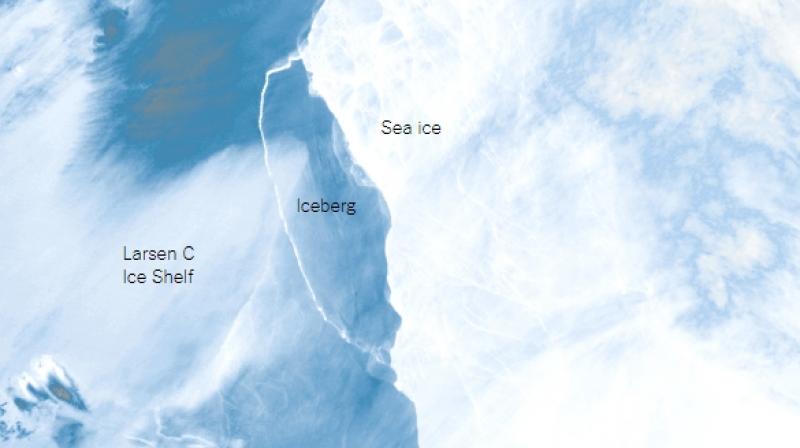Giant iceberg breaks off Antarctica

A Delaware-sized iceberg, one of the largest ever seen, was set adrift after snapping from a West Antarctic ice shelf that will be closely watched for signs of collapse, scientists said Wednesday.
A crack in the Larsen C ice shelf, a drifting extension of the land-based ice sheet, finally broke through after inching its way across the frozen formation for years.
It created an iceberg of about 5,800 square kilometres (2,200 square miles), with a volume twice that of Lake Erie, one of the North American Great Lakes.
"The iceberg weighs more than a trillion tonnes, but it was already floating before it calved away so has no immediate impact on sea level," said a team of researchers from the MIDAS Antarctic research project.
Also read: Don’t worry about the huge Antarctic iceberg – worry about the glaciers behind it
The gargantuan ice cube will probably be named A68.
"The calving of this iceberg leaves the Larsen C ice shelf reduced in area by more than 12 per cent, and the landscape of the Antarctic Peninsula changed forever," the team added.
Separation occurred somewhere between Monday and Wednesday, and was recorded by a NASA satellite.
The calving of ice shelves occurs naturally, though global warming is thought to have accelerated the process in some regions. Warmer ocean water erodes the underbelly of the ice shelves, while rising air temperatures weaken them from above.
Icebergs calving from Antarctica are a regular occurrence, and there are thousands of them.
The latest behemoth will be closely watched for potential risk to ships.
"The big ones are easier to spot in the ocean. This one, for sure, will be tracked very easily by satellite," Mark Drinkwater, a European Space Agency (ESA) ice expert, told AFP.
"The concern is whether the thing breaks up into a myriad of smaller bergs."
There is also a risk that smaller, loose pieces which stayed behind when the main chunk broke off will now calve away.
"There appear to be a number of fractures that might indicate that other pieces might break away later," Drinkwater said.
The fate of A68 is hard to predict.
Drinkwater said it could "hang around" for some time before the tides and wind force it further out to sea.
According to an ESA statement, ocean currents could drag the iceberg, or pieces of it, as far north as the Falkland Islands, posing a hazard for ships in the Drake Passage.
Will it collapse?
Experts disagree over whether the calving heightens the risk of Larsen C disintegrating like its neighbours Larsen B in 2002 and Larsen A in 1995.
Floating on the ocean, ice shelves are fed by slow-flowing glaciers from land. Without them, the glaciers would flow directly into the sea.
If the glaciers held in check by Larsen C were to spill into the Antarctic Ocean, it would lift the global water mark by about 10 centimetres (four inches), previous research has shown.
With its new shape and size, Larsen C may be less stable, the MIDAS researchers warned.
"In the ensuing months and years, the ice shelf could either gradually regrow, or may suffer further calving events which may eventually lead to collapse," said lead investigator Adrian Luckman.

